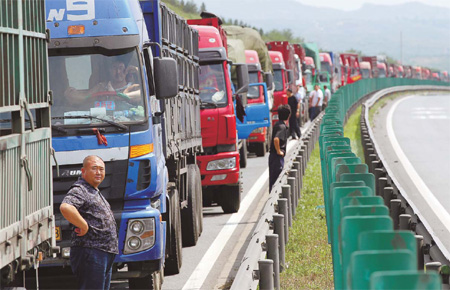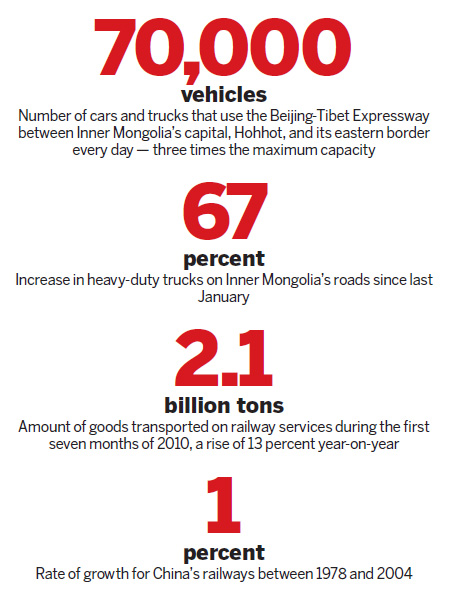Focus
Bottlenecks clog northern artery
By Jiang Xueqing and Cao Li in Beijing and Cheng Yingqi in Zhangjiakou (China Daily)
Updated: 2010-09-14 08:00
 |
Large Medium Small |
|
Truck drivers survey the line of traffic ahead and behind on Aug 27 near Zhangjiakou, Hebei province. Thousands of drivers were affected in two epic traffic jams on the Beijing-Tibet Expressway. Wang Jing / China Daily |
Multiple causes aggravate monster traffic jam. Jiang Xueqing and Cao Li in Beijing and Cheng Yingqi in Zhangjiakou report.
Lu Yong looked through his windscreen toward the snake of unmoving traffic disappearing into the horizon and swore.
"I knew it," he said as he brought his truck to a stop.
It was the second time the driver had been caught in a giant traffic jam on the Beijing-Tibet Expressway in the past month.
"At least I'm not carrying fruit this time," said the 37-year-old, who was ferrying heavy machinery from Baotou in the Inner Mongolia autonomous region to Beijing.
Lu is just one of thousands of drivers caught up in the worst road congestion in recent decades, with many blaming a combination of high demand, limited capacity and ongoing construction work.
However, experts speaking to China Daily insisted the country's inadequate freight rail services have also exacerbated the problem.
Trains offer much larger volumes than heavy-duty trucks, yet most of the vehicles trapped in the congestion, which began with the first jam on Aug 14 and then a second on Aug 27, were carrying coal from Inner Mongolia to the capital.
Official data shows that less than 40 percent of the coal produced in Inner Mongolia is shipped by rail, which is largely due to a shortfall in capacity.
Railway services transported 2.1 billion tons of goods during the first seven months of 2010, a growth of 13 percent year-on-year. However, it is still not enough to meet demand, with China's total coal output alone reaching more than 3 billion tons last year.
"While the country has witnessed double-digit economic growth since the opening policy, its railways grew only about 1 percent between 1978 and 2004," said Liang Chenggu, a publicity official at the Ministry of Railways.
Although there are major plans to expand the nation's network, which already stretches to 86,000 kilometers, most of the work involves high-speed rail links, according to ministry figures.
"High-speed tracks can only be used for passenger services," explained Zhao Jian, a professor with Beijing Jiaotong University's school of economics and management. "The extra cargo capacity only comes when (existing) resources become redundant due to upgraded passenger services."
Some freight services are even halted for spring rush - the 40-day peak travel period during the Chinese New Year holidays - to allow for more passenger trains to run.
"(Resources such as) coal should be transported by rail rather than trucks but the capacity for cargo on the country's railways is just too low," added Guo Xiaobei, director of the National Development and Reform Commission (NDRC)'s institute of comprehensive transportation.
Supply routes
Coal and gas reserves are concentrated in western regions of China, like Shanxi province and Inner Mongolia, while consumption is largely in the east, thousands of kilometers away.
As few companies use rail freight services, the huge demand has put even more strain on a highway network that is struggling to cope with sheer weight of traffic.
Following the widespread closure of small coal mines in Shanxi in the last two years, more provinces in North China have turned to Inner Mongolia for their supplies. Companies in the region produced almost 602 million tons of coal in 2009 (slightly less than Shanxi's 615 million tons) and that figure is expected to rise to 730 million tons this year.
Growth in production means more traffic, however, and the number of heavy-duty trucks in the autonomous region is up 67 percent since last January, according to the Ministry of Public Security.
Hebei province, a major route for mines shipping supplies to eastern coastal areas, also saw an increase of 55 percent over the same period.
The number of vehicles on Inner Mongolia's roads was expected to hit 25,000 to 50,000 in 2033. Although no official figures were available, media reports suggest the region has already surpassed that prediction.
An average of 70,000 cars and trucks use the Beijing-Tibet Expressway between the region's capital Hohhot and its eastern border every day, three times the maximum capacity, said a toll station worker who did not want to be identified.
With winter and the peak time for coal sales approaching, road management authorities have some big challenges ahead, said traffic bureau official Zhang Minghai in Zhangjiakou, a city in Hebei.
To enter Beijing from the northwest, trucks weighing more than 4 tons must pass through the Jingxin Expressway (a section that overlaps the Beijing-Tibet Expressway) in Zhangjiakou, which later merges with Danla, Xuanda and Jingzhang expressways and National Highway 110.
Traffic jams have become a common problem and have caused huge economic losses.
"I could have driven between the two cities three times in the time I wasted stuck in the traffic jam," said trucker Lu Yong. "I could have earned around 900 yuan from each trip."
Authorities in Zhangbei county, one of the city's hottest destinations, have invested more than 2 billion yuan ($295 million) in its tourist industry, yet visitors numbers have fallen by a third since June, as travel agencies cancelled trips to avoid the congestion.
Zhangjiakou's farmers have also been affected as they largely provide vegetables for the capital.

